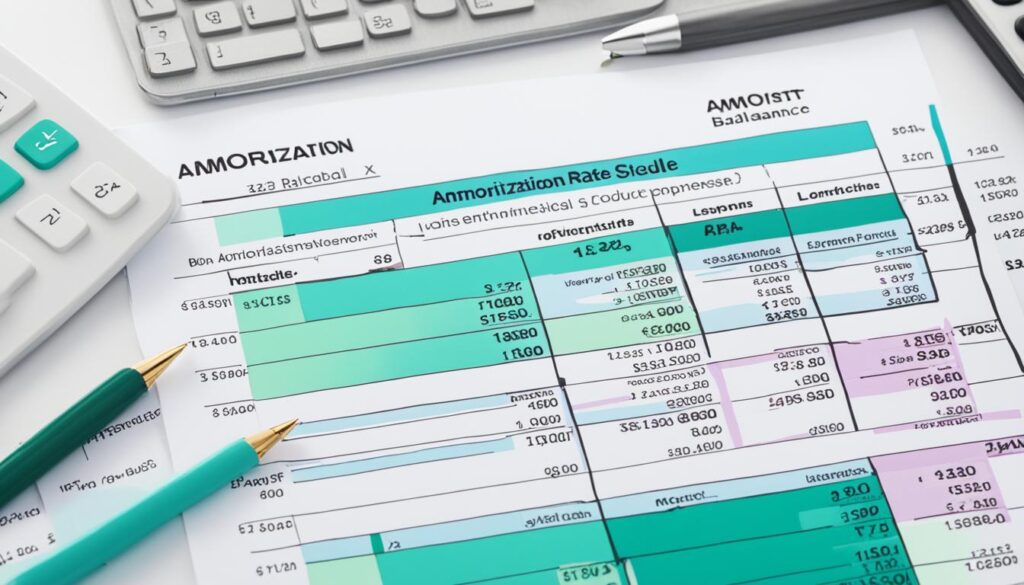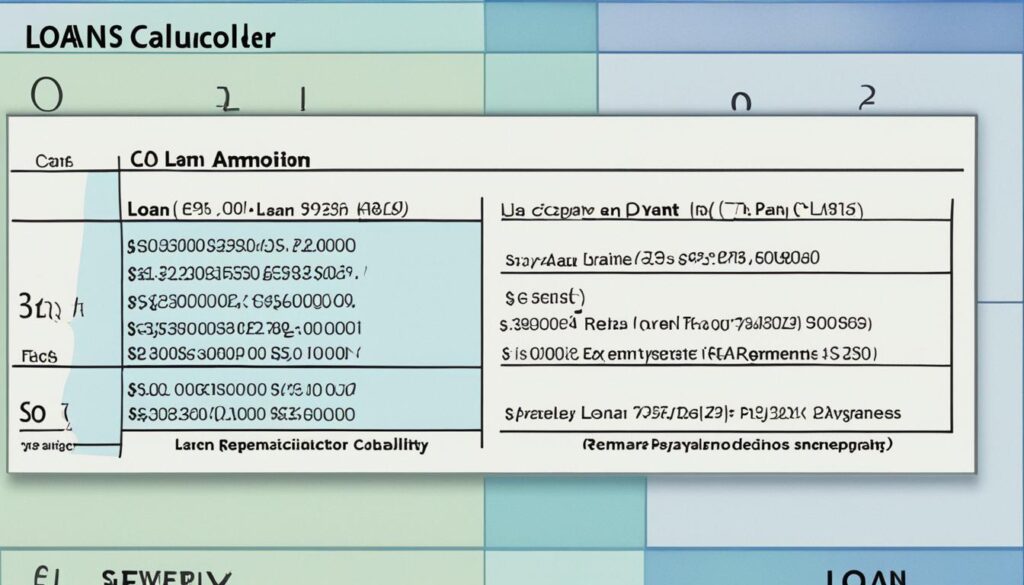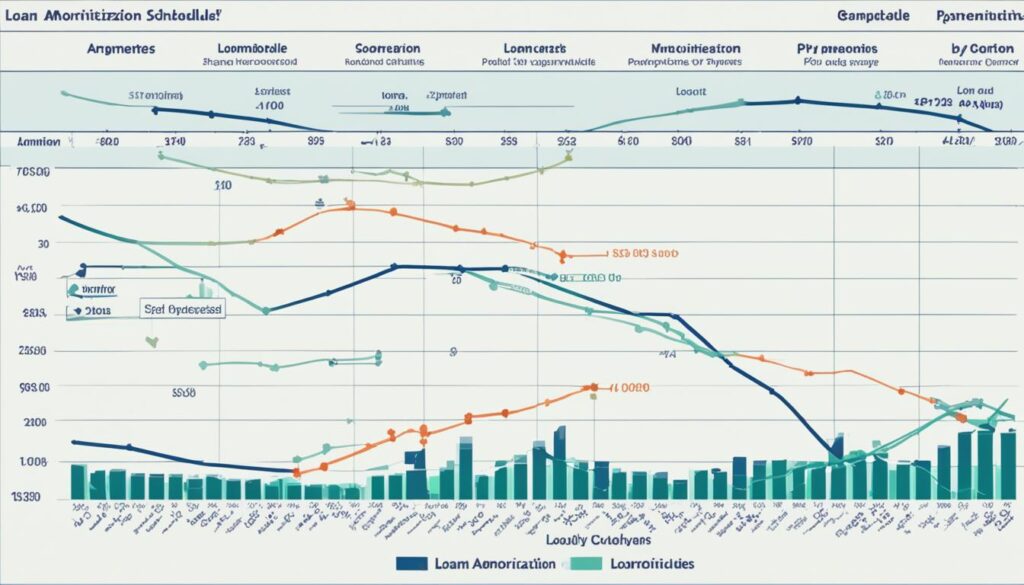Loan amortization calculators are powerful tools that can help borrowers effectively manage their debt and optimize their investments. By understanding the ins and outs of loan amortization, borrowers can make more informed financial decisions and create strategies to pay off their loans efficiently.
Key Takeaways:
- Loan amortization calculators are an essential resource for managing debt and optimizing investments.
- Understanding loan amortization allows borrowers to make informed financial decisions.
- Loan amortization calculators help create efficient strategies to pay off loans.
- Optimizing investments is possible by utilizing loan amortization calculators.
- Managing debt effectively is crucial for financial health.
Understanding Loan Amortization
Loan amortization is a fundamental concept in loan repayment that involves scheduled payments to cover both the principal amount and the interest. It offers borrowers a structured repayment plan by spreading out the loan amount and interest over a set period. The key component in this process is the amortization schedule, which provides detailed information about each payment’s contribution to reducing the loan balance over time.
In every loan amortization schedule, two significant elements play a crucial role: the principal and the interest. The principal, also known as the loan amount, refers to the original borrowed sum. As borrowers make payments, the principal decreases gradually. On the other hand, the interest represents the cost of borrowing the money. Initially, a larger portion of each payment goes towards covering the interest, which gradually decreases over the life of the loan.
The amortization schedule outlines the specifics of each payment, including the amount allocated to both the principal and interest. It provides borrowers with a comprehensive overview of their loan repayment journey, showcasing the gradual reduction of the outstanding balance. This allows borrowers to track their progress and plan their finances accordingly.
Also Read : Loan Commitment Unveiled: Understanding Definition, Mechanisms, And Varieties
“Loan amortization enables borrowers to have a clear understanding of their loan repayment process, allowing them to budget effectively and make informed financial decisions. Utilizing an amortization schedule helps borrowers see the bigger picture and stay on track to pay off their loans.”
Here is an example of an amortization schedule for a $10,000 loan with a 5% interest rate and a repayment period of 5 years:
| Payment Number | Payment Amount | Principal | Interest | Balance |
|---|---|---|---|---|
| 1 | $188.71 | $161.63 | $27.08 | $9,838.37 |
| 2 | $188.71 | $163.42 | $25.29 | $9,674.96 |
| 3 | $188.71 | $165.22 | $23.49 | $9,509.74 |
| 4 | $188.71 | $167.03 | $21.68 | $9,342.71 |
| 5 | $188.71 | $168.85 | $19.86 | $9,173.87 |
This table illustrates how the payment amount remains constant throughout the loan term, while the allocation between principal and interest changes. Over time, the borrower gradually pays off more principal than interest, resulting in a reduction of the outstanding balance.
By understanding loan amortization and utilizing an amortization schedule, borrowers can effectively manage their loan repayment, gain insights into their financial progress, and make informed decisions to optimize their financial strategy.
Also Read : The Rollercoaster Of Variable Loan Interest Rates: Risks And Rewards
How Loan Amortization Works
Loan amortization is a structured repayment process that involves allocating each payment towards both the principal balance and the interest. As borrowers make their scheduled payments, a larger portion initially goes towards the interest, while the remaining amount is applied to reduce the principal balance. Over time, as the principal decreases, the interest portion of each payment decreases as well. This process creates a fixed payment schedule that allows borrowers to track their progress in paying off the loan.
Understanding how loan amortization works is key to effectively managing your debt and optimizing your financial strategy. By consistently making your fixed payments, you gradually chip away at the principal balance, ultimately reducing the total amount owed. With each payment, you not only pay off a portion of the loan but also cover the accrued interest. This gradual reduction in both principal and interest leads to a gradual decrease in the overall balance of your loan.
As you continue to make regular payments, the balance of your loan steadily declines, resulting in a higher proportion of each payment being applied to the principal. This means that over time, you pay less interest and more principal, accelerating your progress towards debt repayment. By adhering to the fixed payment schedule, borrowers can effectively plan their finances and stay on track to pay off their loans within the agreed-upon timeframe.
Also Read : Senior Bank Loans Decoded: Exploring Mechanics, Rates, And Potential Dangers
Benefits of Loan Amortization
Understanding loan amortization and adhering to the fixed payment schedule offers several advantages:
- Structured Repayment: Loan amortization provides borrowers with a structured repayment plan, ensuring that each payment contributes to gradually reducing the principal balance.
- Interest Reduction: Over time, as the principal balance decreases, the interest portion of each payment decreases as well, allowing borrowers to save money on interest payments in the long run.
- Financial Planning: By knowing the exact amount to be paid each month, borrowers can easily plan their financial obligations, ensuring they budget for loan repayments accordingly.
- Progress Tracking: The fixed payment schedule allows borrowers to track their progress in paying off the loan, providing a sense of accomplishment and motivation along the way.
By comprehending how loan amortization works and actively managing your repayments, you can effectively reduce your debt and optimize your financial strategy.
Also Read : Deciphering Whole Loans: Exploring Definition, Operations, and Instances

Components of an Amortization Schedule
When it comes to understanding the repayment of a loan, an amortization schedule plays a crucial role. It consists of several components that provide valuable insights into the loan’s progress and help borrowers track their repayment journey.
Principal
The principal represents the original loan amount borrowed. With each payment made, the principal balance decreases, gradually reducing the overall loan obligation over time. As the principal decreases, more of each payment goes towards paying down the remaining balance rather than the interest.
Interest
Interest is the cost associated with borrowing money. It is calculated based on the outstanding loan balance and decreases over time. In the early stages of loan repayment, a larger portion of each payment is allocated towards interest. As the loan balance reduces, so does the interest portion of each payment, allowing the borrower to build equity in the loan.
Also Read : Revolving Loan Facilities Unpacked: Decoding Their Inner Workings
Total Payment
The total payment is the fixed amount that borrowers are required to pay regularly, usually on a monthly basis. It includes both the principal and interest portions and remains consistent throughout the loan’s term. By breaking down the total payment into its principal and interest components, borrowers can understand how much of their payment goes towards reducing the loan balance versus covering the cost of borrowing.
Balance
The balance represents the remaining principal amount that the borrower owes to the lender after each payment. It reflects the outstanding loan amount yet to be paid off. As borrowers make regular payments, the balance gradually decreases until the loan is fully paid off.
An amortization schedule provides a comprehensive overview of these components, allowing borrowers to visually track their progress and understand how their payments contribute to the overall repayment of their loan.

Types of Loans That Use Amortization
Amortization is a common repayment method used in various types of loans. Understanding how loan amortization applies to different loan types is crucial for effective financial planning and investment strategy.
Mortgage loans, specifically popular among real estate investors, are typically spread over long periods, ranging from 15 to 30 years. These loans allow borrowers to purchase or refinance real estate properties.
Auto loans, on the other hand, are often amortized over shorter periods, typically two to seven years. These loans enable individuals to finance the purchase of vehicles, making them more affordable.
Personal loans can also utilize amortization, depending on the borrower’s creditworthiness and the lender’s terms. Personal loans are versatile and can be used for various purposes, such as debt consolidation, home improvements, or covering unexpected expenses.
Finally, for individuals interested in real estate investing, understanding loan amortization is essential. Whether it’s acquiring rental properties or flipping houses, real estate investors often rely on mortgage loans with amortization to fund their ventures and generate returns.

Potential Features of Each Loan Type:
Loan TypeLoan TermPurposeMortgage Loans15 to 30 yearsReal estate purchase or refinanceAuto Loans2 to 7 yearsVehicle financingPersonal LoansVariesDebt consolidation, home improvements, etc.Real Estate Investing15 to 30 yearsPurchase or flip properties for investment
How to Use an Amortization Calculator
An amortization calculator is a powerful tool that allows borrowers to gain insights into their loan repayment process. By inputting specific loan details, borrowers can generate an amortization schedule that provides a breakdown of each payment. This information can be used to make informed financial decisions and understand the true cost of borrowing.
Calculating Loan Details:
To use an amortization calculator effectively, borrowers need to input the following loan details:
- Loan Amount
- Interest Rate
- Loan Term
- Start Date
These details are crucial in creating an accurate amortization schedule that reflects the specific loan terms and conditions.
Understanding Calculation Results:
Once the loan details are entered, the amortization calculator generates an amortization schedule. This schedule outlines the monthly payments for the specified loan term.
The calculation results provide valuable information, including:
- Principal and Interest Breakdown: Each payment’s breakdown into principal and interest components.
- Total Interest Paid: The cumulative amount of interest paid over the loan term.
- Total Payment: The fixed amount payable each month, inclusive of both principal and interest.
- Remaining Balance: The outstanding principal balance after each payment.
By interpreting the calculation results, borrowers can make strategic financial decisions. For example, they can determine the potential impact of making extra payments or assess the total interest paid over the loan term.
Here is an example of an amortization schedule generated by the calculator:
“`
| Payment Number | Payment Date | Payment Amount | Principal | Interest | Remaining Balance |
|---|---|---|---|---|---|
| 1 | Jan 1, 2022 | $500 | $300 | $200 | $10,000 |
| 2 | Feb 1, 2022 | $500 | $305 | $195 | $9,695 |
| 3 | Mar 1, 2022 | $500 | $310 | $190 | $9,385 |
“`
Note: The example table above is just a sample and not based on actual loan details. The values provided are for illustrative purposes only.
By using an amortization calculator and analyzing the generated schedule, borrowers can gain a comprehensive understanding of their loan repayment journey. This information empowers them to make informed financial decisions, remain on track with their budget, and optimize their overall debt management strategy.
Below is an image visually representing the loan amortization process:
Tips for Maximizing the Benefits of Loan Amortization Calculators
Using a loan amortization calculator is just the first step towards managing your loans effectively and optimizing your financial strategy. To fully maximize the benefits of these calculators, borrowers should consider the following tips:
1. Understand the basics of loan amortization
Before diving into the intricacies of loan amortization calculators, it’s essential to have a solid understanding of loan amortization itself. Familiarize yourself with how principal and interest payments work, and how they contribute to reducing the loan balance over time. This knowledge will help you interpret and utilize the results provided by the calculator effectively.
2. Explore different loan scenarios
Loan amortization calculators allow you to input various loan details, such as different interest rates or loan terms. Take advantage of this feature to explore different hypothetical scenarios. By comparing the payment schedules and total loan costs of these scenarios, you can make more informed decisions about the loan that best fits your financial goals.
3. Consider making extra payments
If you have the financial means, consider making extra payments towards your loan. Inputting these extra payments into the loan amortization calculator can help you visualize how they impact the loan’s total cost and duration. By strategically allocating additional funds towards your loan, you can pay off your loans faster and save on interest payments in the long run.
4. Evaluate the total cost of the loan
Loan amortization calculators not only provide accurate payment schedules but also calculate the total cost of the loan over its duration. Take the time to assess this total cost and consider how it aligns with your financial goals. Understanding the true cost of the loan can help you make more informed decisions about borrowing and potentially identify opportunities for cost savings.
5. Compare different loan options
Utilize the loan amortization calculator to compare different loan options side by side. By inputting the details of each loan, such as interest rates and loan terms, you can see how they stack up against each other in terms of payment schedules and total loan costs. This comparison allows you to choose the loan that offers the most favorable terms and aligns with your financial goals.
By following these tips and utilizing loan amortization calculators effectively, you can gain a better understanding of your loans, make informed financial decisions, and work towards paying off your loans faster. Loan amortization calculators are valuable tools that can empower you in managing your finances and optimizing your loan repayment strategy.

| Benefits of Maximizing Loan Amortization Calculators |
|---|
| Accurate payment schedules |
| Enhanced loan comparisons |
| Improved understanding of total loan cost |
| Efficient strategy to pay off loans faster |
Benefits of Using a Loan Amortization Calculator
Loan amortization calculators offer numerous benefits for borrowers. Whether you’re planning to buy a house, purchase a car, or take out a personal loan, these calculators can help you make informed financial decisions and effectively manage your loan repayment. Here are some key advantages of using a loan amortization calculator:
Accurate Payment Schedules
An accurate payment schedule is crucial for budgeting and managing your expenses. Loan amortization calculators generate detailed schedules that outline each payment’s breakdown, including the principal amount and the interest. By having a clear understanding of your payment obligations, you can plan your budget accordingly and ensure that you make accurate and timely payments.
Loan Comparisons
When you’re considering different loan options, a loan amortization calculator can be a valuable tool for comparing their terms and features. By inputting the details of each loan into the calculator, you can see side-by-side comparisons of the payment schedules, interest charges, and total loan costs. This allows you to make an informed decision about which loan best fits your financial needs.
Total Loan Cost
Loan amortization calculators not only provide information about individual payments but also calculate the total cost of the loan over its term. By considering factors such as the interest rate, loan amount, and repayment period, you can gain a comprehensive understanding of the overall cost of borrowing. This knowledge can help you evaluate the long-term affordability of the loan and explore strategies to reduce the total cost.
Paying Off Loans Faster
One of the key advantages of using a loan amortization calculator is the ability to explore strategies for paying off your loan faster. By inputting extra payment amounts into the calculator, you can see how they impact the loan’s repayment timeline and the amount of interest saved. This feature allows you to devise a payoff strategy that aligns with your financial goals, potentially saving you money and helping you become debt-free sooner.
Overall, loan amortization calculators empower borrowers with accurate payment schedules, the ability to compare loan options, insights into the total loan cost, and strategies for paying off loans faster. Taking advantage of these calculators can not only optimize your financial decision-making but also help you achieve your financial goals more efficiently.

Note: The image above illustrates the importance of accurate payment schedules in managing your loan repayments effectively.
Expert Tips for Maximizing the Benefits of Loan Refinancing
When considering loan refinancing, it’s essential to evaluate your current financial situation to determine if it’s the right move for you. Evaluating your finances will help you understand if refinancing can provide significant benefits and improve your overall financial well-being.
Researching and comparing lenders is another crucial step in maximizing the benefits of loan refinancing. Take the time to explore different lenders and their loan refinancing options. Look for lenders who offer competitive interest rates, favorable terms, and excellent customer service.
Understanding the costs involved in loan refinancing is vital for making an informed decision. Consider all the fees associated with refinancing, such as origination fees, closing costs, and appraisal fees. Calculate the potential savings and weigh them against the costs to determine if refinancing is financially advantageous.
Additionally, carefully considering the loan term can maximize the benefits of refinancing. Evaluate whether a shorter or longer loan term aligns better with your financial goals. A shorter loan term may result in higher monthly payments but could save you more on interest in the long run.
By following these expert tips, you can make informed decisions when it comes to loan refinancing. Take the time to evaluate your current financial situation, research lenders, understand the costs, and consider the loan term that best suits your needs. Doing so will help you find the best refinancing option and maximize the benefits of loan refinancing.
| Expert Tips for Maximizing Loan Refinancing Benefits |
|---|
| Evaluate your current financial situation |
| Research and compare lenders |
| Understand the costs involved |
| Consider the loan term |
The Benefits of Understanding Your Loan Amortization Schedule
Understanding your loan amortization schedule can greatly benefit your financial management. It allows you to plan for future payments, accurately budget for loan obligations, and make informed decisions based on the total cost of the loan. Being aware of your loan amortization schedule also enables you to devise effective loan repayment strategies, such as making extra payments, which can save you money on interest and help you pay off your loan faster.
Also Read:- Kotak Bank Personal Loan: केवक 2 मिनट में पाए कोटक महिंद्रा बैंक से ₹50000 से 40 लाख तक का पर्सनल लोन
By having a clear understanding of your loan amortization schedule, you can align your financial management with your loan repayment strategy. You will be able to anticipate upcoming payments and budget accordingly, ensuring that you have the necessary funds available when needed. This level of financial foresight helps you avoid late payments and potential penalties, promoting better financial stability and peace of mind.
Your loan amortization schedule also provides valuable insights into the total cost of your loan. By analyzing the schedule, you can see how much interest you will be paying over the life of the loan. Armed with this information, you can evaluate the true cost of the loan and make more informed decisions about your borrowing options. This knowledge allows you to prioritize your loan repayment and potentially save money by exploring alternatives such as refinancing or making additional payments.
In addition to understanding the financial implications of your loan, your amortization schedule can guide you in creating an effective loan repayment strategy. By carefully examining the schedule, you can identify opportunities to pay off your loan faster and save on interest. For example, you may decide to make extra payments towards the principal balance, which reduces the outstanding amount and reduces the overall interest accrued. Your amortization schedule serves as a roadmap for achieving your loan repayment goals and accelerating your path towards financial freedom.
Succinctly, your loan amortization schedule empowers you to take control of your financial management. It enables you to accurately plan and budget for loan payments, make informed decisions based on the total cost of the loan, and devise effective loan repayment strategies. By harnessing the power of this knowledge, you can optimize your financial strategy, minimize interest expenses, and achieve your financial goals.
| Benefits of Understanding Your Loan Amortization Schedule |
|---|
| Accurate planning and budgeting for loan payments |
| Informed decision-making based on the total cost of the loan |
| Devising effective loan repayment strategies |
| Minimizing interest expenses and accelerating debt payoff |
Conclusion
Loan amortization calculators are invaluable tools for borrowers looking to optimize their financial strategy. By understanding the concept of loan amortization and utilizing these calculators, borrowers can effectively manage their loan repayment and make well-informed financial decisions.
Through careful analysis of the loan amortization schedule provided by these calculators, borrowers can create a strategic plan that aligns with their financial goals. By following expert tips, such as considering loan refinancing options and making extra payments, borrowers can further optimize their loan repayment and potentially save money on interest.
By implementing these strategies and taking advantage of the capabilities of loan amortization calculators, borrowers can unlock the full potential of their financial strategy. Whether it’s paying off a mortgage or managing personal loans, these calculators empower individuals to take control of their finances and achieve their desired outcomes.
FAQs
Q: What is a loan amortization calculator?
A: A loan amortization calculator is a tool that helps you determine the breakdown of your monthly mortgage payments, showing how much goes towards the principal and interest over the term of the loan.
Q: How does a loan calculator help in financial planning?
A: A loan calculator assists in financial planning by allowing you to estimate your monthly payments, understand how much of each payment goes towards interest and principal, and see the total amount you will repay over the course of the loan.
Q: What is the significance of principal and interest in loan amortization?
A: Principal is the initial amount borrowed, while interest is the cost of borrowing the money. Understanding how your payments are divided between these two components is crucial for managing your finances effectively.
Q: How does mortgage amortization impact loan repayment?
A: Mortgage amortization refers to the process of paying off a loan over time with regular payments. By calculating your monthly amortization, you can track your progress in repaying the loan and adjust your financial strategy accordingly.
Q: How can I estimate my monthly mortgage payments using a loan calculator?
A: You can use a mortgage amortization calculator to estimate your monthly payments by entering the loan amount, interest rate, and term. The calculator will provide you with a breakdown of each payment, including the portion that goes towards interest and principal.
Q: What is the role of an amortization schedule calculator in loan management?
A: An amortization schedule calculator helps you visualize how your loan will be paid off over time. It shows the distribution of payments towards interest and principal, allowing you to plan ahead and make informed financial decisions.
Q: How does the length of the loan affect monthly payments?
A: The length of the loan impacts the amount of each monthly payment. A longer loan term may result in lower monthly payments but higher overall interest costs, while a shorter term will lead to higher monthly payments but lower interest expenses.
